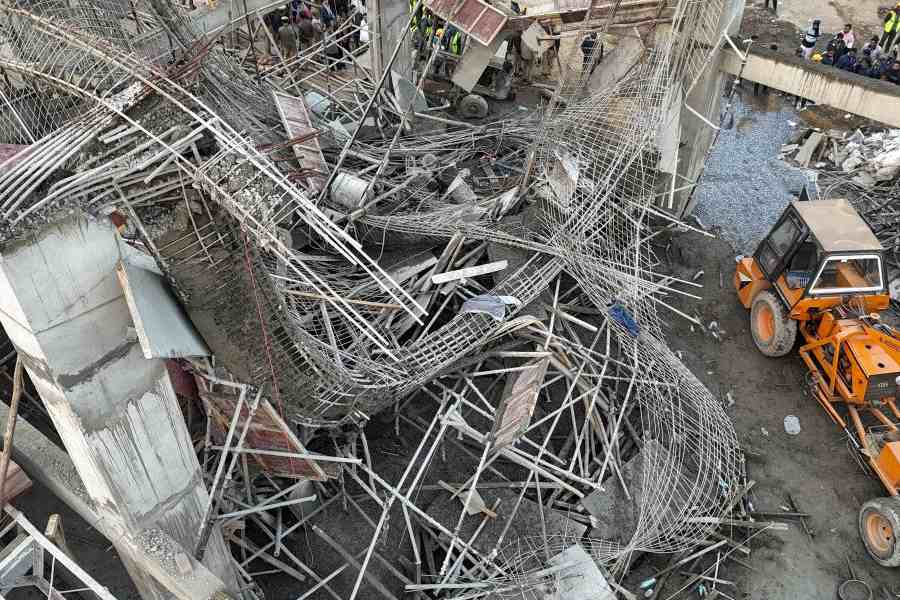The low base on which the national income projections will be made for the next fiscal provides the Centre some room to present high growth figures for the next fiscal along with lower fiscal deficit but that will hurt the credibility of the budget exercise, analysts said.
The economy is expected to contract 7.7 per cent in the current financial year compared with the growth rate of 4.2 per cent in 2019-20, according to the first advance estimates of national income.
Nominal gross domestic product (GDP) or GDP at current prices in the year 2020-21 is likely to attain a level of Rs 194.82 lakh crore against the provisional estimate of GDP for the year 2019-20 of Rs 203.40 lakh crore, released on May 31, 2020.
The contraction in nominal GDP during 2020-21 is estimated at 4.2 per cent, the statistical ministry said.
Nominal GDP measures a country's gross domestic product using current prices, without adjusting for inflation. Contrast this with real GDP, which measures a country's economic output adjusted for the impact of inflation.
Economists have expressed concern over the possibility of an unrealistic assumption of economic growth because of the lower base.
“The finance ministry faces a tough balancing act in the Union budget as it aims to stabilise the public finances while avoiding economically and politically-damaging spending cuts,” Shilan Shah, senior India Economist, Capital Economics, said.
“The most likely outcome is that it will set ambitious revenue targets and quietly shift some spending off- balance sheet, allowing it to present a smaller headline deficit. This may keep the bond market on the side for the time being. But obfuscation of the true fiscal position risks undermining credibility over the long term,” Shah said.
N.R. Bhanumurthy, vice-chancellor of the Bangalore-based Dr B.R. Ambedkar School of Economics University said “fiscal deficit as a ratio of GDP will see a significant improvement compared with what is expected in the current year, assuming that next year is going to be a normal year. Though the NSO (National Statistics Office) has projected (-) 4.2 per cent as nominal growth for the current year, but, my own projection is that we may be somewhere close to zero. If the NSO numbers are right, the budget may assume nominal GDP growth of somewhere close to 15 per cent for next year, if you assume zero growth.
“But, if its NSO estimate, then it may go to 16-17 percent. If that is the case, revenue projection is going to be substantially higher next year. Although there may be some slippage on the expenditure side, especially since we may want to spend more on vaccines and other health-related activities, the fiscal deficit could fall by at least 1.0-1.5 percentage points next year from the current year.”
“I think most people are projecting a 7 per cent fiscal deficit for the current year, so the next year could be somewhere closer to 5.5-6.0 per cent,” he added.
Sonal Varma, chief economist of Nomura, said, “We expect the central government’s fiscal deficit to widen to 6.8 per cent of GDP in 2021021, nearly double the original budget target of 3.5 per cent , but better than previously feared 8 per cent), aided by a sequential improvement in revenues and a muted rise in spending.
“With expenditures supported by strong nominal growth, optimism on tax collection and the government’s aggressive estimates for disinvestment and non-tax proceeds, we expect the fiscal deficit target to be set at 5.3 per cent of the gross domestic product in 2021-22.”
Shah said “historically, the Finance Ministry has been adept at masking policy looseness in the budget figures when it wants to give an impression of fiscal consolidation. Typically, this is done by adopting ambitious revenue assumptions for the Goods and Services Tax and asset sales. The Finance Ministry is highly likely to use this strategy once again. Another trend over recent years has been for the Finance Ministry to shift some of its expenditure off-balance sheet. Given the conflicting pressures, we suspect that the authorities will continue to ramp up off-budget activities in FY21-22. Taken together, we think that Finance Minister Nirmala Sitharaman will announce a central fiscal deficit target of around 5% of GDP for FY21-22, and outline a roadmap to bring the deficit down to 3% of GDP over the next few years. The Finance Ministry will hope that is sufficient to keep bond yields close to their current lows.”
The budget document of the past 10 years shows that nominal GDP growth of 14 per cent was projected in fy12 and fy 13. However, fy14 and fy15 including the interim budget projected nominal GDP growth of 13.4 per cent. Since then the finance ministers have been projecting nominal growth between 11 and 12 per cent with the budget for fy21 projecting nominal growth of 10 percent.
N.R. Bhanumurthy, vice-chancellor of the Bengaluru-based Dr B.R. Ambedkar School of Economics University said “fiscal deficit as a ratio of GDP will see a significant improvement compared with what is expected in the current year, assuming that next year is going to be a normal year. Though the NSO has projected (-)4.2% as nominal growth for the current year, but, my own projection is that we may be somewhere close to zero. If the NSO numbers are right, then the Budget may assume nominal GDP growth of somewhere close to 15.0% for next year, if you assume zero growth. But, if its NSO estimate, then it may go to 16-17 percent.”
“If that is the case, revenue projection is going to be substantially higher next year. Although there may be some slippage on the expenditure side, especially since we may want to spend more on vaccines and other health-related activities, the fiscal deficit could fall by at least 1.0-1.5 percentage points next year from the current year. I think most people are projecting a 7.0% fiscal deficit for the current year, so the next year could be somewhere closer to 5.5-6.0%,” he added.
Bhanumurthy said “for the next year, I am hoping that the 15th Finance Commission would have provided a clear roadmap so that the government may start from there and suggest how they are going to bring down the fiscal deficit to whatever the targeted level at the end of five years. Hoping that it would have suggested some range targets with every year some leeway clause for the government to work around.”
“The prepone-ing of the budget has led to deterioration of fiscal marksmanship. If the first advance estimates undergo significant revision, then nominal GDP growth keeps changing. We go badly in the next year’s GDP forecast, and other projections like revenue collection, which is the core of any budget exercise,” he added.
Sonal Varma, chief economist of Nomura said “we expect the central government’s fiscal deficit to widen to 6.8% of GDP in FY21, nearly double the original budget target of 3.5%, but better than previously feared 8%), aided by a sequential improvement in revenues and a muted rise in spending. With expenditures supported by strong nominal growth, optimism on tax collection and the government’s aggressive estimates for disinvestment and non-tax proceeds, we expect the fiscal deficit target to be set at 5.3% of GDP in FY22.”
She said “a combination of factors – the lagged impact of easy financial conditions, the ‘vaccine pivot’, and improving global growth prospects should lead to a strong growth outturn in FY22 real GDP growth of 13.5%, on our estimates. Consequently, we expect the government to assume nominal GDP growth of 15% y-o-y inFY22, more conservative relative to our estimate of 17% from -4.2% y-o-y in FY21 (advance estimates).”
“The GDP to witness a turnaround in FY2022, with 10.1% growth in real terms, in contrast to the 7.8% contraction expected in FY2021. We expect the Union Budget for FY2022 to assume a nominal GDP growth of 14-15% in FY2022, higher than the 10% assumption that was made in the Budget for FY2021. In this note, we are using our projections for nominal GDP of Rs. 194.2 trillion for FY2021 and Rs. 221.4 trillion for FY2022,” rating agency ICRA in a research note.











